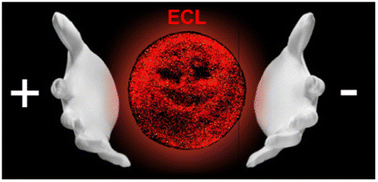Wireless electrochemical light emission in ultrathin 2D nanoconfinements†
Abstract
Spatial confinement of chemical reactions or physical effects may lead to original phenomena and new properties. Here, the generation of electrochemiluminescence (ECL) in confined free-standing 2D spaces, exemplified by surfactant-based air bubbles is reported. For this, the ultrathin walls of the bubbles (typically in the range of 100–700 nm) are chosen as a host where graphene sheets, acting as bipolar ECL-emitting electrodes, are trapped and dispersed. The proposed system demonstrates that the required potential for the generation of ECL is up to three orders of magnitude smaller compared to conventional systems, due to the nanoconfinement of the potential drop. This proof-of-concept study demonstrates the key advantages of a 2D environment, allowing a wireless activation of ECL at rather low potentials, compatible with (bio)analytical systems.



 Please wait while we load your content...
Please wait while we load your content...